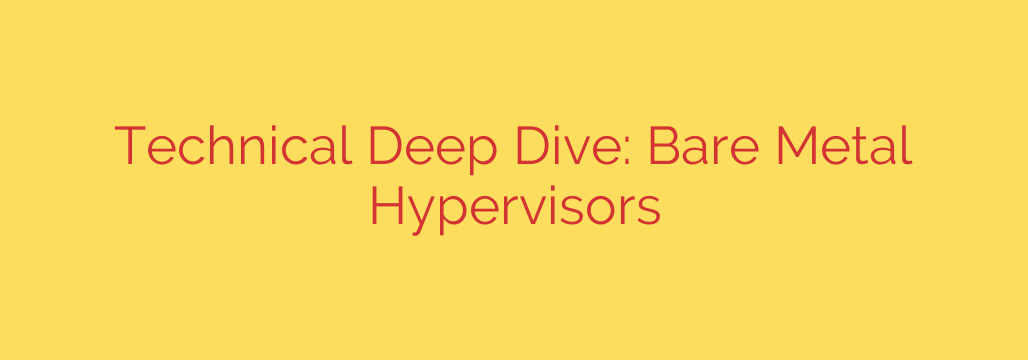
What is a Bare Metal Hypervisor? The Foundation of Modern Cloud Computing
In the world of cloud computing and enterprise IT, virtualization is the engine that powers everything. It allows a single physical server to run multiple, independent operating systems and applications simultaneously. At the heart of this technology lies a crucial piece of software known as the hypervisor. But not all hypervisors are created equal.
For environments demanding the highest levels of performance, security, and stability, the bare metal hypervisor is the undisputed standard. Also known as a Type 1 hypervisor, this technology is the foundation upon which today’s most powerful data centers and cloud platforms are built.
Let’s dive into what a bare metal hypervisor is, how it works, and why it’s essential for modern infrastructure.
The Core Concept: Direct Hardware Control
The defining characteristic of a bare metal hypervisor is that it is installed directly on the host’s physical hardware, just like a traditional operating system. It doesn’t require a pre-existing OS to function. It is the operating system, a specialized one designed for a single purpose: to run virtual machines (VMs).
By sitting directly on the “bare metal,” the hypervisor has privileged and direct access to all the server’s resources—CPU, memory, storage, and networking. It acts as a traffic cop, efficiently and securely partitioning these resources and allocating them to the various guest VMs that run on top of it.
Popular examples of bare metal (Type 1) hypervisors include:
- VMware ESXi
- Microsoft Hyper-V
- Kernel-based Virtual Machine (KVM)
- Xen Project
This direct-to-hardware architecture is the key to its power and efficiency.
Bare Metal (Type 1) vs. Hosted (Type 2) Hypervisors
To fully appreciate the benefits of a bare metal approach, it helps to compare it with its counterpart: the hosted hypervisor.
A hosted, or Type 2, hypervisor runs as a software application on top of a conventional operating system (like Windows 10, macOS, or a Linux distribution). Think of applications like Oracle VirtualBox or VMware Workstation. You install them on your computer just like any other program to create and run VMs.
The key difference lies in the layers. A Type 2 hypervisor has to go through the host operating system to access the physical hardware. This creates an extra layer of software that introduces overhead, increases latency, and can create potential security vulnerabilities.
| Feature | Bare Metal (Type 1) Hypervisor | Hosted (Type 2) Hypervisor |
| :— | :— | :— |
| Installation | Directly on physical server hardware | On top of a host operating system |
| Performance | High performance with low overhead | Slower due to OS overhead |
| Security | More secure with a smaller attack surface | Less secure; a vulnerability in the host OS can affect VMs |
| Resource Use | Highly efficient resource management | Less efficient; shares resources with the host OS |
| Primary Use Case | Enterprise data centers, cloud computing, production servers | Desktop use, development, testing, and learning |
While hosted hypervisors are excellent for development and testing on a personal computer, they are not suitable for the demanding workloads of a production environment.
The Key Benefits of a Bare Metal Hypervisor Architecture
Organizations choose bare metal hypervisors for mission-critical applications for several compelling reasons.
Exceptional Performance: By eliminating the host OS layer, a bare metal hypervisor provides guest VMs with near-native access to the hardware. This significantly reduces latency and overhead, ensuring applications run as fast and efficiently as possible. This is critical for databases, high-traffic web servers, and other performance-sensitive workloads.
Enhanced Security: Security is a major advantage. Since the hypervisor itself is a small, hardened piece of software with a limited purpose, its attack surface is much smaller than that of a full-featured operating system. Furthermore, strong isolation is enforced between VMs. If one VM is compromised, the breach is contained and cannot spread to other VMs on the same host.
Superior Scalability and Resource Management: Bare metal hypervisors are built to manage resources at scale. Administrators have granular control over how much CPU, RAM, and storage each VM receives. Advanced features like dynamic resource allocation allow the hypervisor to shift resources to where they are most needed, maximizing the efficiency and utilization of the physical hardware.
High Availability and Reliability: Enterprise-grade bare metal hypervisors are the core of high-availability clusters. Features like live migration (e.g., VMware vMotion) allow running VMs to be moved from one physical host to another with zero downtime, enabling hardware maintenance or load balancing without interrupting service.
Best Practices for Securing Your Hypervisor
While inherently secure, a hypervisor is a high-value target for attackers. Compromising it means gaining control over every VM it hosts. Following security best practices is non-negotiable.
- Keep Your Hypervisor Patched: Treat your hypervisor like any other critical piece of infrastructure. Regularly apply security patches from the vendor to protect against known vulnerabilities.
- Implement Strong Access Control: Limit administrative access to the hypervisor. Use role-based access control (RBAC) to ensure that users have only the permissions they absolutely need to perform their jobs.
- Isolate Management Traffic: The network used to manage the hypervisor should be isolated from normal VM and user traffic. This prevents attackers on the production network from being able to reach the management interface.
- Harden the Configuration: Follow vendor guidelines for hardening the hypervisor. This often involves disabling unused services and ports to further reduce the attack surface.
- Monitor and Audit Everything: Actively monitor hypervisor logs for any unusual activity or failed login attempts. Regular auditing helps ensure that security configurations remain in place and are effective.
In conclusion, the bare metal hypervisor is the workhorse of the modern data center. Its architecture delivers the performance, security, and scalability required to power the cloud services and enterprise applications we rely on every day. By running directly on the hardware, it provides a robust and efficient foundation for the entire virtualized world.
Source: https://www.redswitches.com/blog/bare-metal-hypervisors/








